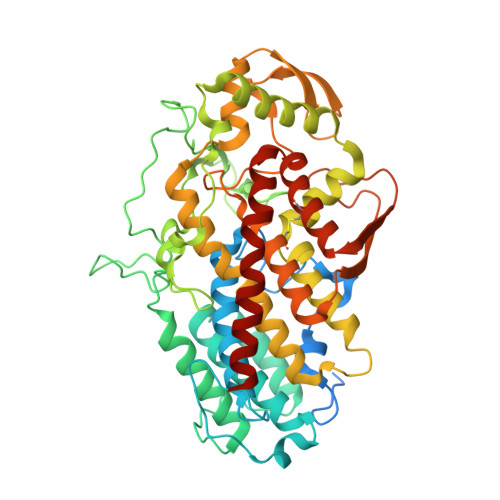Structural Basis of Stereospecific Vanadium-Dependent Haloperoxidase Family Enzymes in Napyradiomycin Biosynthesis.
Chen, P.Y., Adak, S., Chekan, J.R., Liscombe, D.K., Miyanaga, A., Bernhardt, P., Diethelm, S., Fielding, E.N., George, J.H., Miles, Z.D., Murray, L.A.M., Steele, T.S., Winter, J.M., Noel, J.P., Moore, B.S.(2022) Biochemistry
- PubMed: 35985031
- DOI: https://doi.org/10.1021/acs.biochem.2c00338
- Primary Citation of Related Structures:
3W35, 3W36, 8CXL - PubMed Abstract:
Vanadium-dependent haloperoxidases (VHPOs) from Streptomyces bacteria differ from their counterparts in fungi, macroalgae, and other bacteria by catalyzing organohalogenating reactions with strict regiochemical and stereochemical control. While this group of enzymes collectively uses hydrogen peroxide to oxidize halides for incorporation into electron-rich organic molecules, the mechanism for the controlled transfer of highly reactive chloronium ions in the biosynthesis of napyradiomycin and merochlorin antibiotics sets the Streptomyces vanadium-dependent chloroperoxidases apart. Here we report high-resolution crystal structures of two homologous VHPO family members associated with napyradiomycin biosynthesis, NapH1 and NapH3, that catalyze distinctive chemical reactions in the construction of meroterpenoid natural products. The structures, combined with site-directed mutagenesis and intact protein mass spectrometry studies, afforded a mechanistic model for the asymmetric alkene and arene chlorination reactions catalyzed by NapH1 and the isomerase activity catalyzed by NapH3. A key lysine residue in NapH1 situated between the coordinated vanadate and the putative substrate binding pocket was shown to be essential for catalysis. This observation suggested the involvement of the ε-NH 2 , possibly through formation of a transient chloramine, as the chlorinating species much as proposed in structurally distinct flavin-dependent halogenases. Unexpectedly, NapH3 is modified post-translationally by phosphorylation of an active site His (τ-pHis) consistent with its repurposed halogenation-independent, α-hydroxyketone isomerase activity. These structural studies deepen our understanding of the mechanistic underpinnings of VHPO enzymes and their evolution as enantioselective biocatalysts.
Organizational Affiliation:
Center for Marine Biotechnology and Biomedicine, Scripps Institution of Oceanography, University of California, San Diego, La Jolla, California 92093, United States.















